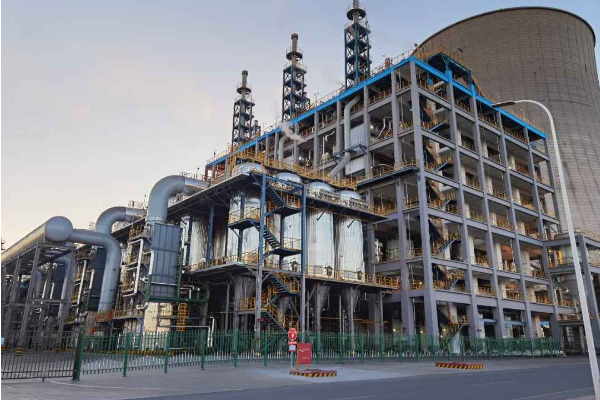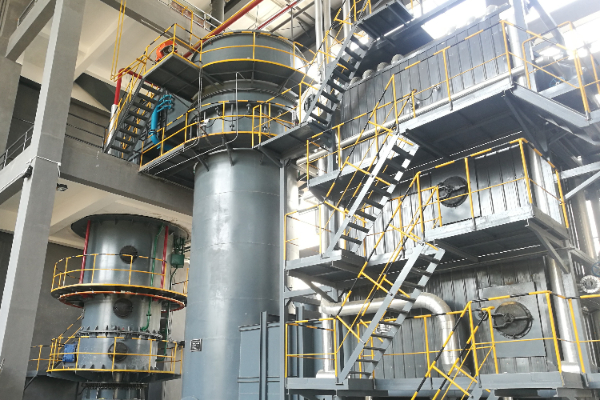Refractory materials are key components of water-coal slurry pressurized gasifiers, and their operating performance is one of the key factors in whether the gasifier can operate over a long period, safely and economically.

Analysis of damage mechanism of refractory lining
During the use of refractory materials, due to the corrosion and erosion caused by high temperature or temperature changes, atmosphere changes, and slag, the damage forms are complex and the damage mechanisms are diverse. In summary, the damage forms of refractory materials are mainly mechanical damage and chemical erosion.
Mechanical damage
Mechanical damage to refractory materials mainly includes damage caused by thermal spalling, structural spalling, high-temperature thermal fatigue, and mechanical impact. “Thermal shock” is inevitable during the use of gasifier refractory materials, which is one of the main causes of mechanical damage to refractory materials.
The so-called thermal shock refers to the impact on refractory materials when their operating temperature changes significantly. GE has a definition of a thermal cycle, that is, when the temperature changes by 100°C within 1 hour, it is called a thermal cycle, which we can also classify as thermal shock. Gasifiers are prone to thermal shock during the process of baking, feeding, and parking, especially during feeding and parking. During the baking process, due to improper control of negative pressure and baking fuel, the furnace temperature may change significantly in a short period of time, which is mainly manifested in the increase of the temperature difference between the upper and lower combustion chambers of the gasifier and the excessive local temperature. At this time, the overall thermal expansion will be uneven, which may cause local cracks or bricks to be crushed. During the feeding process, since both coal slurry and oxygen are low-temperature media, they enter the furnace within 1 minute. At this time, the furnace temperature is generally around 1000℃. By observing the changes in the furnace temperature on the DCS, it can be found that at the moment of feeding, the temperature in the furnace first drops and then rises. The drop is because the cold medium enters the high-temperature environment and absorbs a lot of heat. The rise is because when the temperature of coal slurry and oxygen reaches a certain value, they will undergo a violent oxidation reaction and burn. Therefore, each feeding is equivalent to two “thermal shocks” for the refractory materials of the gasifier. During the shutdown process, in order to ensure the cleanliness of the oxygen pipeline and coal slurry pipeline, the two main material pipelines must be purged with nitrogen. Each time the gasifier is stopped, the nitrogen entering the combustion chamber of the gasifier is reduced from 13MPa to about 11.3MPa. The entry of about 1000m3 of nitrogen will also cause the temperature of the refractory materials to drop suddenly, so each shutdown process is also equivalent to a “thermal shock”. From the operation process, it can be concluded that the more times the gasifier is started and stopped, the higher the probability of mechanical damage to the refractory materials.
In the early stage of system operation, due to insufficient understanding of this type of large furnace and unstable furnace operation, the gasification furnace was frequently started and stopped. In some cases, it was operated at a lower temperature, which was one of the reasons for the short life of the refractory materials.

Chemical attack
The refractory materials used in water-coal slurry pressurized gasifiers are composed of a variety of high-melting-point compounds, the main component of which is Cr2O2. The Cr2O2 content of the refractory materials currently used for the fire surface can be as high as 90% or more, and the rest are Al2O2, ZrO2, and other components. Among these compounds, some have polymorphism, that is, the same compound has multiple crystal structures (crystal forms). When conditions change, it will transform from one crystal form to another. If a compound has several crystal forms, only the one with the lowest free energy can exist stably under a certain temperature and pressure. For example, a compound has two types of crystal forms, crystal form I and crystal form II. When the temperature is lower than a certain value, only crystal form I can exist stably; when the temperature rises to a certain value, a transition between crystal form I and crystal form II occurs. When the temperature is higher than this temperature, only crystal form II can exist stably. For the refractory materials of the water-coal slurry pressurized gasifier, when only the temperature is considered without considering other factors, the temperature requirement is not more than 1500℃. Since the crystal transformation is often accompanied by changes in volume (or density) and other properties, when the crystal transformation occurs in the refractory, cracking, loosening or pulverization may occur, thus affecting its overall service life.
If the slag penetrates into the pores inside the refractory, it will not only promote the melting and erosion of the refractory but also be an important reason for the chemical erosion of the material and the structural peeling, thereby accelerating its damage. Once the slag penetrates into the pores inside the refractory, it will immediately react with it, causing the working surface to deteriorate, and the result will be that the penetrated area becomes very loose under high-temperature conditions. Some people have done relevant experiments. When the temperature reaches 1300℃, the penetration depth of the slag into the interior of the refractory brick can reach 30mm. As for the water-coal slurry pressurized gasification technology itself, within the existing range of coal types, the operating temperature of most coal types cannot reach below 1300℃, from which we can draw the following conclusion: the erosion of refractory materials by slag is almost inevitable during normal production. In order to extend the service life of refractory materials, after a large number of industrial exploration tests, we found that Cr₂O₃ reacts with Fe₂O₃, Al₂O₃, FeO, and MgO in the slag to form a composite spinel (Mg, Fe)O(Al, Cr, Fe)₂O₃, which forms a dense protective layer on the surface of the refractory material, preventing further erosion of the slag. The most effective way to prevent slag from penetrating into the interior of the refractory material is to increase the viscosity of the slag, which can be achieved by controlling the viscosity-temperature characteristics of the slag.
 Rongsheng Group
Rongsheng Group

WeChat
Scan the QR Code with wechat